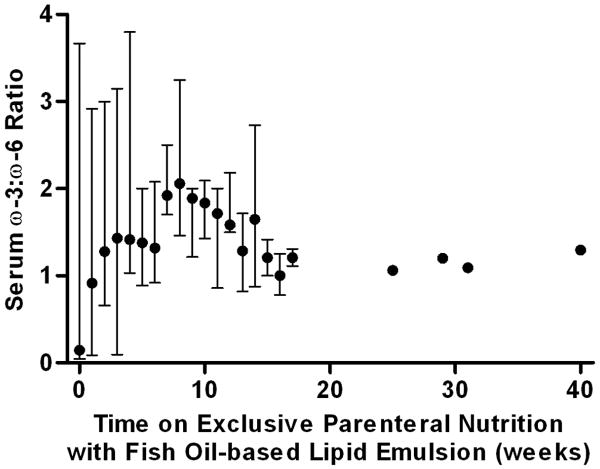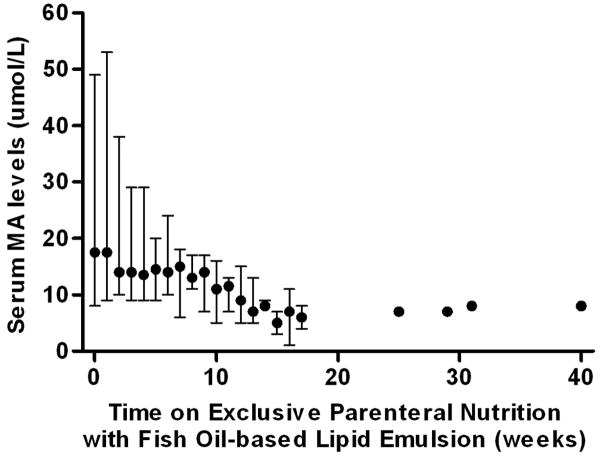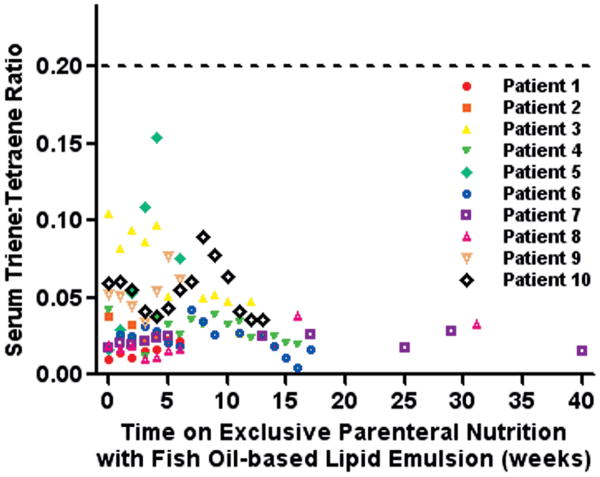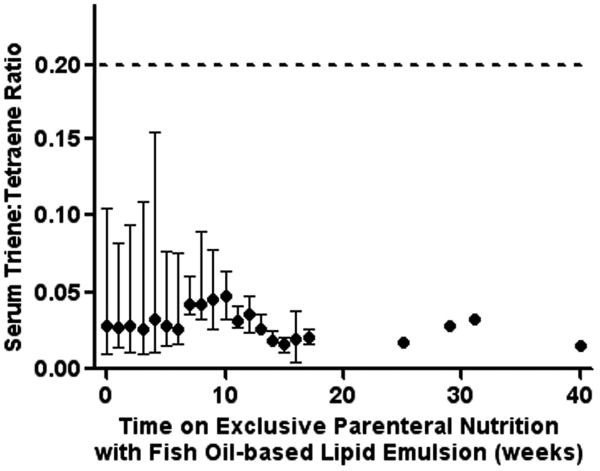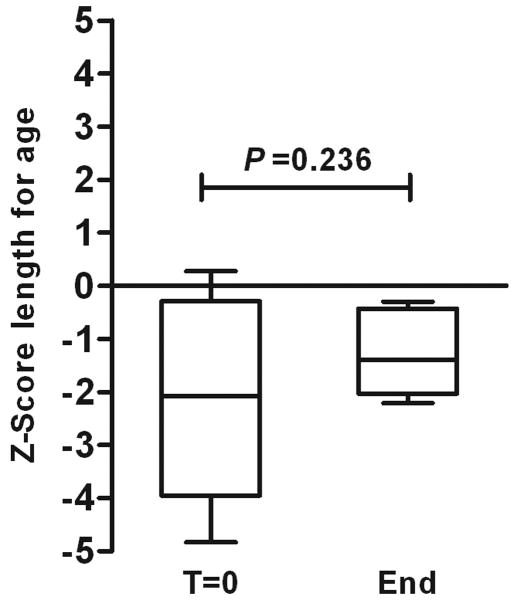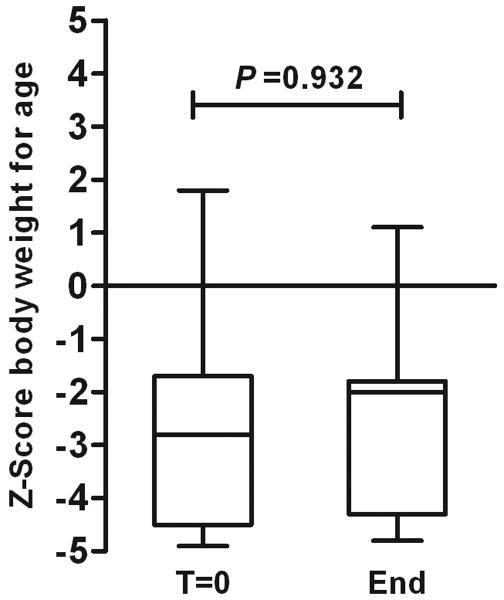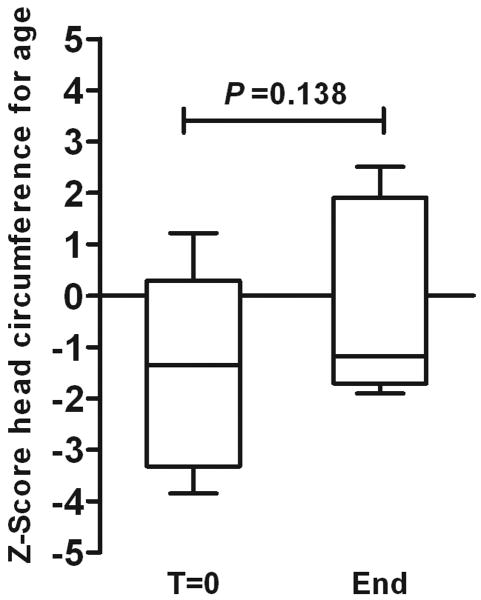Abstract
Objective
The use of fish oil-based emulsions as the sole source of fat for patients receiving parenteral nutrition (PN) has raised concerns for the development of essential fatty acid deficiency (EFAD), hindering its adoption into clinical practice. The purpose of this study was to examine fatty acid profiles of patients receiving no enteral calories, while completely dependent on PN and an intravenous fish oil-based lipid emulsion, for onset of EFAD and maintenance of growth.
Methods
Prospectively collected data from ten patients was reviewed for evidence of EFAD, defined as a triene:tetraene ratio greater than 0.2. Gestational age-adjusted Z-scores for length, growth and head circumference at baseline were compared to the corresponding Z-scores at time of censoring. All patients received PN with a fish oil-based lipid emulsion at 1 g.kg−1.day−1 as the sole source of fat calories for at least 1 month. The fish oil monotherapy was used under a compassionate use protocol.
Results
Median gestational age at time of birth was 35 weeks, and median age at the start of treatment was 3.5 months. After a median time of 3.8 months on exclusive PN and fish oil-based lipid emulsion, none of the patients developed biochemical or clinical evidence of EFAD. Z-scores were not statistically different, indicating no growth impairment. Median direct bilirubin levels improved in 9 patients from 6.8 mg/dL to 0.9 mg/dL (P=0.009).
Conclusions
When dosed appropriately, fish oil-based lipid emulsions contain sufficient amounts of essential fatty acids to prevent EFAD and sustain growth in patients completely dependent on PN.
Keywords: omega-3, fish oil, parenteral nutrition, parenteral nutrition-associated liver disease, essential fatty acid deficiency
Introduction
Parenteral Nutrition (PN) is an established modality to provide the necessary nutrient requirements for patients with intestinal abnormalities or when the use of the gastrointestinal tract is contraindicated. PN is typically administered in conjunction with an intravenous lipid emulsion to provide an alternative to carbohydrates as a source of non-protein calories, and supplies polyunsaturated fatty acids to prevent essential fatty acid deficiency (EFAD) (1,2). Currently in the United States, the only approved intravenous lipid emulsions are derived from either soybean oils alone or a combination of soybean and safflower oils. Recent evidence, however, suggests that these emulsions significantly contribute to the onset of PN associated liver disease, which is associated with high morbidity and mortality (3-5).
Polyunsaturated fatty acids (PUFAs) have many physiological functions, including providing the integrity and fluidity of cellular membranes, serving as major constituents of phospholipids, triglycerides and cholesterol esters in plasma lipoprotein particles, and are precursors of numerous bioactive eicosanoids and prostanoids (6,7). Traditionally, alpha-linolenic acid (ALA, ω-3) and linoleic acid (LA, ω-6) are considered the only ‘essential fatty acids’ as they cannot be synthesized in mammalian tissues and are required for normal physiological development, growth and function (8). Other ω-3 and ω-6 PUFAs can be derived from these two fatty acid precursors by elongation and desaturation reactions. Eicosapentaenoic acid (EPA, ω-3), docosahexaenoic acid (DHA, ω-3), and arachidonic acid (AA, ω-6), are considered ‘conditionally essential fatty acids’ because their production may be inadequate in selective conditions such as prematurity and rapid growth (9). Oleic acid (OA, ω-9) is a monounsaturated FA that can be synthesized by de novo lipogenesis in mammals. OA can be converted via intermediates to mead acid (MA, ω-9), which typically accumulates in conditions of EFAD. The ratio of this compound to AA, i.e., the triene:tetraene ratio, is used as a diagnostic marker for EFAD (10).
Although relatively rare, EFAD can occur in as little as a few days in infants, and within several weeks in older children and adults with chronic malnutrition and malabsorption. EFAD may also occur within weeks in patients receiving prolonged courses of PN with inadequate fat intake (11). Due to their limited fat stores, premature infants may develop EFAD in less than a week when their intake of essential fatty acids is less than 4-5% of their total caloric intake (12). EFAD may lead to dermatitis, growth retardation, hair loss, infertility, impaired vision, coagulopathies, susceptibility to infections, as well as to hepatosteatosis induced by de novo lipogenesis (10-13).
Recent investigation has focused on the hepatoprotective effects of fish oil as a monotherapy alternative to soybean oil (14-17). Fish oil-based lipid emulsions have been available in Europe and Asia for more than ten years as a supplement, but their use as the sole source of fat energy, however, is not recommended by its manufacturer because of concerns that the low levels of the traditional essential fatty acids, i.e. linoleic acid and alpha-linolenic acid, present in fish oils could lead to EFAD. Studies have shown that, in a subset of pediatric patients, parenteral fish oil as monotherapy led to reversal of EFAD, improved liver function and maintained adequate growth (14-17). Also, it has been shown that the ω-3 PUFAs such as ALA, EPA and DHA, which are more prevalent in fish oil compared to soybean oil, might play a role in reducing the amount of the ω-6 PUFA LA required to prevent EFAD (18). Skepticism, however, remains sufficient to hinder the adoption of fish oil-based emulsions as monotherapy into clinical practice (19).
To test the hypothesis that parenteral fish oil as monotherapy prevents EFAD in PN dependent patients, we examined the fatty acid profiles and growth parameters of patients exclusively administered PN and a fish oil-based lipid emulsion for the onset of EFAD.
Methods
Patients
This study was approved by the Children's Hospital Boston Committee on Clinical Investigation (protocol no. 05-04-048). From April 2005 to February 2009, infants who developed cholestasis (serum direct bilirubin ≥2 mg/dL) while receiving PN with soybean based lipid emulsions were switched to a fish oil-based lipid emulsion (Omegaven® Fresenius Kabi, Bad Homburg VDH Germany) and prospectively followed under a compassionate treatment protocol. A subset of ten patients (70% male) who exclusively received PN with the fish oil-based lipid emulsion as the sole source of fat calories for at least 1 month were included for analysis. When a baseline fatty acid profile was unavailable prior to start of the fish oil therapy, the patient was considered ineligible for analysis. Patients were censored when they advanced to enteral feeding, and censoring was assumed independent to essential fatty acid status. Although we censored patients when they advanced to enteral feeds, some did receive minimal oral intake for comfort during the study period (Patients 1, 2, 4, 7, and 9). Due to severe malabsorption from their microvillous inclusion disease, it was very unlikely that patients 1 and 2 had any significant caloric absorption from the Pedialyte® (Abbott Nutrition, Columbus, Ohio) and breast milk that they received for comfort. Patient 7 received a few crackers a day, but had a previous failed intestinal transplant that was subsequently explanted and literally had no gut. Patients 4 and 9 sporadically received Pedialyte® during the study period, but this sugar and electrolyte based formula did not contribute to any fat calories.
Study Treatment
After obtaining informed consent, the soybean based lipid emulsion, Intralipid® (Fresenius Kabi, Uppsala, Sweden), was discontinued and treatment with the fish oil-based lipid emulsion, Omegaven®, was started. Intralipid® is mainly comprised of LA (ω-6), and only contains a small amount of ALA (ω-3). In contrast, Omegaven® contains significant amounts of the ω-3 PUFAs EPA and DHA and only a small amount of ω-6 PUFAs (Table 1). All patients received Omegaven® at a goal dose of 1 g.kg−1.day−1 that was infused over 12-20 hours. Dosing was based on the previous use of fish oil-based lipid emulsions as monotherapy (14,15). Protein intake was 2.5 g.kg−1.day−1 for full-term infants, and 3-3.5 g.kg−1.day−1 for premature infants. The initial rate of dextrose infusion was approximately 5 mg.kg−1.min−1, and due to the fact that we limited fat administration, extra caloric intake was provided by increasing dextrose intake. Since Omegaven® is not yet approved for use in the United States, approval was obtained from the Food and Drug Administration (IND 73,488) for its compassionate use.
Table 1. Comparison of the parenteral lipid emulsions per 10g/100mL.
| Product | Intralipid® (Fresenius Kabi) | Omegaven® (Fresenius Kabi) |
| Oil source (%) | ||
| Soybean | 100 | 0 |
| Fish | 0 | 100 |
| Fat composition (g) | ||
| Palmitic acid C16:0 | 1 | 0.25-1 |
| Stearic acid C18:0 | 0.4 | 0.05-0.2 |
| Oleic acid C18:1 ω-9 | 2.6 | 0.6-1.3 |
| LA C18:2 ω-6 | 5 | 0.1-0.7 |
| ALA C18:3 ω-3 | 0.9 | <0.2 |
| EPA C20:5 ω-3 | 0 | 1.28-2.82 |
| AA C20:4 ω-6 | 0 | 0.1 -0.4 |
| DHA C22:5 ω-3 | 0 | 1.44-3.09 |
| Phytosterols (mg/L) | 348±33 | 0 |
| α-Tocopherol (mg/L) | 38 | 150-296 |
Data as provided by manufacturers. LA indicates linoleic acid; ALA, alpha-linolenic acid; EPA, eicosapentaenoic acid; AA, arachidonic acid; DHA, docosahexaenoic acid.
Study Outcomes
The primary study outcome was the onset of EFAD, defined as a triene:tetraene ratio greater than 0.2. Fatty acid profiles were measured from blood samples obtained before the start of Omegaven® and weekly thereafter until direct serum bilirubin levels were <2mg/dL, at which time fatty acid profiles were obtained monthly. All fatty acid analyses were performed at the same clinical laboratory (Mayo Laboratories, Rochester MN). Direct bilirubin was measured using a modified Jendrassik-Grof assay. As a secondary study outcome, the onset of clinical parameters for EFAD, including dermatitis, hair loss and growth impairment, was systematically recorded. Z-scores for length, weight and head circumference, corrected for gestational age, were analyzed as anthropometric measurements for growth.
Estimated Nutrient and Essential Fatty Acid Intake
To gain insight in the caloric intake derived from carbohydrate, protein and fat during our study, we arbitrarily picked a time point of 1 month after the initiation of fish oil monotherapy. For the calculation, we used male gender, a median weight of 4.8 kg, height of 52 cm and age of 4.5 months. Using the recommendations from the American Academy of Pediatrics for infants <10kg (100 kcal.kg−1.day−1), we calculated an estimated daily caloric requirement of 480 kcal.day−1 (20). Using the information in table 2, and given that the energy density of a 10% Omegaven® emulsion is 1.12 kcal/mL, we calculated that LA, ALA, EPA, DHA and AA accounted for 0.8-5.6%, <1.6%, 10.3-22.7%, 11.6-24.8% and 0.8-3.2% of fat calories, respectively, when given at a dose of 1 g.kg−1.day−1.
Table 2. Patient clinical and biochemical data.
| Patient | Gestational Age (wk) | Gender | Original diagnosis | Age (months) | Direct bilirubin (mg/dL) | ||
|---|---|---|---|---|---|---|---|
| T=0 | End | T=0 | End | ||||
| 1 | 36 | Male | Microvillous inclusion disease | 4.9 | 8.2 | 7.8 | 0.1 |
| 2 | 36 | Male | Microvillous inclusion disease | 3.7 | 4.9 | 6.1 | 1.3 |
| 3 | 25 | Male | Necrotizing enterocolitis | 3.2 | 5.9 | 4.1 | 0.1 |
| 4 | 35 | Male | Jejunal atresia | 1.1 | 4.8 | 2.7 | 0.1 |
| 5 | 24 | Male | Hirschsprung's disease | 1.8 | 3.2 | 9.6 | 8.9 |
| 6 | 35 | Female | Jejunal atresia | 0.8 | 4.8 | 2.5 | 0.1 |
| 7 | 38 | Female | Rejected intestinal transplant | 37.4 | 46.7 | 4.2 | 0.5 |
| 8 | 38 | Female | Neuroblastoma, short bowel | 26.0 | 33.1 | 12.8 | 2.4 |
| 9 | 24 | Male | Necrotizing enterocolitis | 5.7 | 7.0 | 7.5 | 9.6 |
| 10 | 32 | Male | Necrotizing enterocolitis | 2.1 | 5.1 | 8.4 | 5.6 |
T=0 indicates at baseline; End, at censoring.
Statistical Analysis
Z-scores and direct bilirubin levels were expressed as median (range) and differences were assessed using a paired non-parametric Wilcoxon Signed Ranks Test. P<0.05 was considered statistically significant. All data were collected in a computerized Microsoft Excel database (Microsoft Inc., Redmond, WA). The analysis was performed with SPSS version 16.0 (SPSS Inc., Chicago, IL) statistical software, and figures were created using GraphPad Prism version 5.0 (GraphPad Software Inc., La Jolla, CA) software.
Results
The median gestational age at the time of birth was 35 weeks (range 24 to 38 weeks), and median age at the start of study treatment was 3.5 months (range 0.8 to 37 months). Due to underlying intestinal abnormalities, all patients had inadequate intestinal length requiring PN (Table 2). All patients experienced significant cholestasis, indicated by direct bilirubin levels ranging from 2.5 to 12.8 mg/dL (median 6.8 mg/dL) at baseline (Table 2).
Fatty Acid Analysis
At baseline, all patients except patients 3 and 9 had fatty acid profiles comparable to the composition of the soybean-based lipid emulsion (tables 1 and 3), characterized by high absolute and relative levels of the ω-6 PUFAs LA and AA, low levels of the ω-3 PUFAs EPA and DHA, and low ω-3:ω-6 ratios (Table 3). Patients 3 and 9, diagnosed with necrotizing enterocolitis (NEC), had already been switched to Omegaven® therapy due to severe cholestasis for 1 and 3 months, respectively, and became eligible for the study when oral intake was withheld due to NEC related complications. Therefore, their fatty acid profiles at baseline already showed elevated levels of EPA and DHA, decreased levels of LA, and high ω-3:ω-6 ratios (Table 3).
Table 3.
Concentration of relevant fatty acids at baseline, 3- and 6-week time points for individual patients.
| Patient 1 | Patient 2 | Patient 3 | Patient 4 | Patient 5 | Patient 6 | Patient 7 | Patient 8 | Patient 9 | Patient 10 | |
|---|---|---|---|---|---|---|---|---|---|---|
| Alpha-linolenic acid, C18:3 ω-3 (μmol/L) | ||||||||||
| Baseline | 130 | 28 | 23 | 41 | 87 | 96 | 365 | 101 | 21 | 51 |
| 3 wk | 52 | 23 | 29 | 24 | 11 | 54 | 48 | 80 | 33 | 74 |
| 6 wk | 41 | 36 | 34 | 16 | 17 | 49 | 118 | 34 | 18 | 44 |
| Linoleic acid, C18:2 ω-6 (μmol/L) | ||||||||||
| Baseline | 2746 | 1580 | 411 | 1362 | 2811 | 2354 | 4084 | 3022 | 1020 | 1402 |
| 3 wk | 1631 | 1211 | 549 | 602 | 350 | 1188 | 1216 | 2069 | 759 | 1207 |
| 6 wk | 1434 | 1323 | 527 | 694 | 428 | 1296 | 1877 | 1583 | 902 | 852 |
| Mead acid, C20:3 ω-9 (μmol/L) | ||||||||||
| Baseline | 14 | 20 | 41 | 19 | 8 | 8 | 16 | 14 | 21 | 49 |
| 3 wk | 14 | 11 | 28 | 9 | 22 | 17 | 11 | 13 | 9 | 29 |
| 6 wk | 13 | 10 | 12 | 10 | 24 | 15 | 14 | 10 | 16 | 19 |
| Arachidonic acid, C20:4 ω-6 (μmol/L) | ||||||||||
| Baseline | 1386 | 370 | 389 | 21 | 492 | 472 | 940 | 742 | 404 | 836 |
| 3 wk | 919 | 348 | 289 | 242 | 202 | 554 | 494 | 1331 | 262 | 700 |
| 6 wk | 602 | 434 | 240 | 383 | 316 | 783 | 571 | 615 | 262 | 344 |
| Eicosapentaenoic acid, C20:5 ω-3 (μmol/L) | ||||||||||
| Baseline | 124 | 8 | 1449 | 33 | 37 | 37 | 56 | 29 | 718 | 71 |
| 3 wk | 1546 | 554 | 1492 | 755 | 477 | 1110 | 678 | 2072 | 773 | 1669 |
| 6 wk | 1097 | 1046 | 1042 | 856 | 828 | 1302 | 963 | 940 | 664 | 889 |
| Docosahexaenoic acid, C22:6 ω-3 (μmol/L) | ||||||||||
| Baseline | 293 | 54 | 1627 | 139 | 38 | 154 | 208 | 107 | 485 | 178 |
| 3 wk | 2210 | 779 | 1903 | 979 | 479 | 1683 | 1149 | 1987 | 565 | 2290 |
| 6 wk | 1298 | 986 | 1403 | 1185 | 786 | 1534 | 1714 | 983 | 519 | 1484 |
| triene:tetraene ratios | ||||||||||
| Baseline | 0.010 | 0.054 | 0.105 | 0.042 | 0.016 | 0.017 | 0.017 | 0.019 | 0.052 | 0.059 |
| 3 wk | 0.015 | 0.032 | 0.097 | 0.037 | 0.109 | 0.031 | 0.022 | 0.010 | 0.034 | 0.041 |
| 6 wk | 0.022 | 0.023 | 0.050 | 0.026 | 0.076 | 0.019 | 0.025 | 0.016 | 0.061 | 0.055 |
| ω-3:ω-6 ratios | ||||||||||
| Baseline | 0.156 | 0.045 | 3.667 | 0.143 | 0.057 | 0.100 | 0.148 | 0.098 | 0.867 | 0.154 |
| 3 wk | 1.500 | 0.882 | 3.800 | 2.111 | 1.833 | 1.579 | 1.105 | 1.216 | 1.364 | 2.095 |
| 6 wk | 1.227 | 1.211 | 2.000 | 1.833 | 2.000 | 1.409 | 1.419 | 0.917 | 1.083 | 2.077 |
The fatty acid profiles gradually changed to the composition of the fish oil-based lipid emulsion during the study (Table 1). Fatty acid profiles after 3 and 6 weeks show decreasing levels of LA and AA, and increasing amounts of EPA and DHA (Table 3). All weekly fatty acid profiles showed a consistent pattern of gradual change to the composition of fish oil (data not shown).
Onset of Essential Fatty Acid Deficiency
At baseline, all of the patients' triene:tetraene ratios were below 0.2, hence none of them had EFAD. After 1 week, the ω-3:ω-6 ratios had increased from a median 0.146 (range 0.045 to 3.667) to a median ratio of 0.915 (range 0.088 to 2.917) (Figure 1A). Median ω-3:ω-6 ratios gradually increased during the study and remained between 1:1 to 2:1 in all patients. MA levels remained normal in all patients, indicating that none of the patients experienced EFAD associated de novo lipogenesis (Figure 1B). After a median time of 3.8 months (range 1.2 to 9.3 months) on exclusive PN along with a fish oil-based lipid emulsion, none of the patients developed biochemical evidence of EFAD before the end of the study period (Figure 2A and Figure 2B).
Figure 1.
Fatty acid profiles in patients on fish oil monotherapy demonstrated an increase in ω-3 fatty acids. Mead acid levels remained low, suggesting de novo lipogenesis was not increased. Median serum ω-3:ω-6 ratios (A) and mead acid levels (B) on a weekly basis from patients on exclusive parenteral nutrition and fish oil-based lipid emulsion. Whiskers extend to the extreme values.
Figure 2.
Patients on fish oil monotherapy did not develop essential fatty acid deficiency (EFAD). Individual (A) and median (B) serum triene:tetraene ratios of patients exclusively on parenteral nutrition with fish oil-based lipid emulsion on a weekly basis. The dashed line indicates the lower limit for biochemical EFAD and whiskers extend to the extreme values.
During the course of the study, none of the patients experienced any clinical signs of EFAD. Specifically, we did not observe EFAD associated dermatitis, hair loss, coagulopathies or increased infection rates related to Omegaven® monotherapy (data not shown). Further, patients did not experience growth retardation. Median baseline and end of study Z-scores for length for age were -2.1 (range -4.8 to 0.3), and -1.4 (range -2.2 to -0.3), respectively (P=0.236, Figure 3A). Median Z-scores for weight were -2.8 (range -4.9 to -1.8) at baseline, and -2.0 (range -4.8 to 1.1) at end of the study (P=0.932, Figure 3B). For head circumference, median baseline Z-scores were -1.4 (range -3.9 to 1.2), compared to -1.2 (range -1.9 to 2.5) at the end of the study (P=0.138, Figure 3C). Only patient 8 did not improve her growth rate during the 7.1 months that she was studied; however, she was also receiving post-operative chemotherapy after intestinal resection for neuroblastoma. All her weekly triene:tetraene ratios were below 0.05 and she did not develop any clinical signs of EFAD.
Figure 3.
Patients on fish-oil monotherapy did not exhibit growth impairment. Median Z-scores for length (A), weight (B) and head circumference (C) adjusted for gestational age at baseline (T=0) and at the time of censoring (End), showing no significant differences (P=0.236, P=0.932 and P=0.138, respectively). The solid bar within the box represents the median value; upper boundary of the box, the 75th percentile; lower boundary of the box, 25th percentile. Whiskers extend to the extreme values.
Improvement of Cholestasis
After a median time of 3.8 months (range 1.2 to 9.3 months) on exclusive PN and Omegaven® monotherapy, median direct bilirubin levels improved in 90% of the patients from a median of 6.8 mg/dL (range 2.5 to 12.8 mg/dL) to a median level of 0.9 mg/dL (range 0.1 to 9.6 mg/dL; P=0.009). Six of the ten patients had their direct bilirubin normalized. Patients 5 and 10 had their direct bilirubin levels improved from 9.6 to 8.8 mg/dL and 8.4 to 5.6 mg/dL, respectively. Their direct bilirubin levels continued to decrease to normal levels after censoring (data not shown). Patient 8 received concomitant chemotherapy for neuroblastoma, but showed a major decrease in direct bilirubin from 12.8 to 2.4 mg/dL. Only patient 9 showed progression of his liver disease indicated by an increase in direct bilirubin from 7.5 mg/dL at baseline to 9.6 mg/dL after 5.6 weeks. Median time to reverse cholestasis with a fish oil-based lipid emulsion, however, was approximately 9.4 weeks (17). Prior to on the initiation of Omegaven®, this 24 week premature male suffered from NEC, pneumonia and central line sepsis, which are all risk factors for developing severe liver disease. In addition, during his hospital stay, this patient developed severe brain hemorrhage, resulting in severe cerebral atrophy and ultimately withdrawal of care.
Estimated Nutrient and Essential Fatty Acid Intake
To gain insight in the caloric intake derived from carbohydrate, protein and fat during our study, we arbitrarily picked a time point of 1 month after the initiation of fish oil monotherapy. For the calculation, we used male gender, a median weight of 4.8 kg, height of 52 cm and age of 4.5 months. Using the recommendations from the American Academy of Pediatrics for infants <10kg, we calculated an estimated daily caloric requirement of 480 kcal.day−1 (20). Estimated caloric intake from parenteral fat was 1 g.kg−1.day−1 = 11.2 kcal.4.8 kg−1.1 day−1 = 53.8 kcal (11.2%). Estimated caloric intake from protein was 2.5 g.kg−1.day−1 = 4 kcal.2.5 g−1.4.8 kg−1.1 day−1) = 48 kcal (10.0%). Estimated caloric intake from carbohydrates was therefore 480 – 53.8 – 48 = 378 kcal (23.2g.kg−1.day−1 of carbohydrate; 78.8%). Using the estimated total daily caloric intake for a 4.8 kg, 52 cm, 4.5 month old male infant who received all fat calories derived from Omegaven®, we calculated that we provided an estimated 0.09-0.63% LA, <0.18% ALA, 1.15-2.54% EPA, 1.30-2.78% DHA and 0.09-0.36% AA of total estimated daily caloric intake.
Discussion
In our center, a parenteral fish oil-based lipid emulsion used as monotherapy in a subset of pediatric PN dependent patients at a dose of 1 g.kg−1.day−1 has been shown to be safe and efficacious in reversing PN associated liver disease and normalizing EFAD status (14-17). In addition to previously published papers by our group, this report adds important data regarding the safety of parenteral fish oil as monotherapy. In contrast to our earlier studies, we present a unique population of 10 parenteral nutrition dependent infants who received no significant enteral calories and received all fats derived from intravenous fish oil. Although this patient population is even more prone to develop EFAD, our results are in line with our previously published data that patients on parenteral fish oil monotherapy do not develop EFAD (14). Also, we previously demonstrated that fish oil, when used at sufficient concentrations, can be used as the sole source of fat, displaying no adverse effects on growth and no evidence of EFAD in a 9-week murine model (18). Despite these results, skepticism had remained that a fish oil-based lipid emulsion may not contain sufficient amounts of LA and ALA to prevent EFAD when used as a monotherapy. Our results show, for the first time, that Omegaven® monotherapy as the sole source of fat in a subset of PN dependent patients does not lead to the onset of clinical or biochemical EFAD.
Although physical signs and symptoms of EFAD in infants may not appear for 4-6 weeks, biochemical abnormalities generally appear in only 1-2 weeks (12). In our study, however, all patients were followed for a minimum of 6 weeks and none of them showed clinical signs of EFAD. A cut-off point for the upper limit for the triene:tetraene ratio as a biochemical marker for EFAD was based on early experiments on rats, that initially suggested it to be 0.4 (21). Further work in humans using the more accurate gas liquid chromatography, however, showed that the upper limit should be 0.2 (22). Although others have argued that the upper limit should be as low as 0.025 (23), this distinction is somewhat semantic since clinical evidence of EFAD is not seen when the triene:tetraene ratio is <0.2. The upper limit, therefore, should be 0.2 as a lower ratio would actually over-diagnose patients with EFAD.
We also demonstrated that these patients did not experience growth retardation, indicated by gestational age adjusted Z-scores for length, weight and head circumference, while on the fish oil based lipid emulsion. In a state of EFAD where ω-3 and ω-6 PUFA stores are depleted, MA is produced by de novo lipogenesis. Data from the fatty acid profiles showed that while being on Omegaven®, MA levels remained within the normal range, and the triene:tetraene ratios remained below 0.2. Also, the relative amount of ω-3 to ω-6 increased in all patients.
Although the median follow-up time was only 3.8 months, this period should exceed the time window for the onset of EFAD. By including only those with a minimum of 4 weeks on exclusive PN and intravenous Omegaven®, we hope to eliminate any false negatives in detecting EFAD. Also, by censoring these patients as soon as they advanced to any enteral feeding, we eliminated any possible confounding from enteral fat calories.
At baseline, all patients had significant liver disease (median direct bilirubin 6.8 mg/dL), as well as multiple other comorbidities, justifying their enrollment in the Omegaven® monotherapy under a compassionate use protocol. At baseline, patients' fatty acid profiles represented the composition of the parenteral lipid emulsions that they had been receiving. It has been suggested that patients with severe liver disease are deficient in long chain PUFAs, and that supplementation may improve patients' clinical condition by correcting this deficiency (24,25). Although none of the 8 patients that had received the soybean-based lipid emulsion were deficient in the total amount of long chain PUFAs, they experienced a low, suboptimal ω-3:ω-6 ratio. Already after 1 week, fatty acid profiles had changed to the composition of fish oil, which has been shown to be less pro-inflammatory and less hepatotoxic (26-28).
Breast milk, which contains considerable amounts of long chain PUFAs, is considered to provide the optimal form of nutrition for young infants. Since long chain PUFAs accumulate mainly during the last trimester of pregnancy, preterm infants have very limited body stores at birth, at a time when its requirement is high due to their rapidly growing state (29). Although a fish oil-based lipid emulsion does not provide the same amounts of fatty acids as breast milk, it contains relatively high levels of EPA and DHA that may play an important role in development of critical organs and cognitive function (29). These effects may be particularly important in preterm infants who receive their entire caloric intake from PN and a parenteral lipid emulsion.
In our study, we calculated that an estimated daily caloric intake of 0.09-0.63% LA, <0.18% ALA, 1.15-2.54% EPA, 1.30-2.78% DHA and 0.09-0.36% AA was enough to prevent EFAD. The estimated amount of ω-3 PUFAs that we provided is higher than reported by Bjerve et al., who estimated that the minimal daily requirement of ω-3 PUFAs was approximately 0.1-0.2% (30). Our patients, however, were growing, young infants (some premature), with significant co-morbidities and a higher need for ω-3 PUFAs, whereas the patients that Bjerve et al. described were relatively healthy, immobile adults fed by gastric tube. Although we provided <0.18% of ALA, our patients received a significantly higher amount of the downstream ω-3 PUFAs EPA and DHA assuring proper physical and mental development (29). Our data does require a note of caution, because we calculated an estimated daily caloric intake based on the median data derived from our study sample. Since this calculation is dependent on infants' weight, height and age, our numbers are presented as a representative snapshot of our study sample, and may not be generalized to the pediatric population as a whole.
In conclusion, we have demonstrated for the first time that a fish oil-based lipid emulsion as monotherapy contains sufficient amounts of essential fatty acids to prevent EFAD and sustain adequate growth in children completely dependent on PN. A randomized, controlled, double-blind clinical trial, such as the one that is currently underway at our institution (NCT00512629), comparing the conventional soybean-based Intralipid® to the fish oil-based Omegaven® as the sole source of parenteral lipid will be imperative in the current debate about the efficacy and safety of parenteral fish oil-based lipid emulsions (31). The results will also determine its role as monotherapy in PN-dependent patients.
Acknowledgments
The authors are grateful to Danielle Arsenault and Elizabeth Robinson for their contribution.
Sources of support: Dr. De Meijer was recipient of fellowships from the foundations Stichting Prof. Michaël-van Vloten Fonds (Venray, The Netherlands), VSBfonds (Utrecht, The Netherlands), Gerrit Jan Mulder Stichting (Rotterdam, The Netherlands), Prins Bernhard Cultuurfonds (Amsterdam, The Netherlands), and Dr Saal van Zwanenberg Stichting (Oss, The Netherlands). Dr. Le was supported by the Joshua Ryan Rappaport Fellowship (Boston, MA). Dr. Puder was supported by the National Institutes of Health and the Children's Hospital Surgical Foundation (Boston, MA). This study was in part funded by the Food and Drug Administration Office of Orphan Products Development. The funders did not participate in the design and conduct of the study; collection, management, analysis, and interpretation of the data; and preparation, review, or approval of the manuscript. Children's Hospital Boston has submitted a patent for the use of Omegaven® on behalf of Drs Gura and Puder.
References
- 1.MacFie J. The development of fat emulsions. Nutrition. 1999;15:641, 643–5. [PubMed] [Google Scholar]
- 2.Wretlind A. Development of fat emulsions. JPEN J Parenter Enteral Nutr. 1981;5:230–5. doi: 10.1177/0148607181005003230. [DOI] [PubMed] [Google Scholar]
- 3.Clayton PT, Bowron A, Mills KA, et al. Phytosterolemia in children with parenteral nutrition-associated cholestatic liver disease. Gastroenterology. 1993;105:1806–13. doi: 10.1016/0016-5085(93)91079-w. [DOI] [PubMed] [Google Scholar]
- 4.Chen WJ, Yeh SL, Huang PC. Effects of fat emulsions with different fatty acid composition on plasma and hepatic lipids in rats receiving total parenteral nutrition. Clin Nutr. 1996;15:24–8. doi: 10.1016/s0261-5614(96)80257-3. [DOI] [PubMed] [Google Scholar]
- 5.De Meijer VE, Gura KM, Le HD, et al. Fish oil-based lipid emulsions prevent and reverse parenteral nutrition-associated liver disease: the Boston experience. JPEN J Parenter Enteral Nutr. 2009 doi: 10.1177/0148607109332773. in press. [DOI] [PubMed] [Google Scholar]
- 6.Salem N, Jr, Wegher B, Mena P, et al. Arachidonic and docosahexaenoic acids are biosynthesized from their 18-carbon precursors in human infants. Proc Natl Acad Sci U S A. 1996;93:49–54. doi: 10.1073/pnas.93.1.49. [DOI] [PMC free article] [PubMed] [Google Scholar]
- 7.Lee S, Gura KM, Kim S, et al. Current clinical applications of omega-6 and omega-3 fatty acids. Nutr Clin Pract. 2006;21:323–41. doi: 10.1177/0115426506021004323. [DOI] [PubMed] [Google Scholar]
- 8.Aaes-Jorgensen E. Essential fatty acids. Physiol Rev. 1961;41:1–51. doi: 10.1152/physrev.1961.41.1.1. [DOI] [PubMed] [Google Scholar]
- 9.Cunnane SC. Problems with essential fatty acids: time for a new paradigm? Prog Lipid Res. 2003;42:544–68. doi: 10.1016/s0163-7827(03)00038-9. [DOI] [PubMed] [Google Scholar]
- 10.Holman RT. The ratio of trienoc: tetraenoic acids in tissue lipids as a measure of essential fatty acid requirement. J Nutr. 1960;70:405–10. doi: 10.1093/jn/70.3.405. [DOI] [PubMed] [Google Scholar]
- 11.Fleming CR, Smith LM, Hodges RE. Essential fatty acid deficiency in adults receiving total parenteral nutrition. Am J Clin Nutr. 1976;29:976–83. doi: 10.1093/ajcn/29.9.976. [DOI] [PubMed] [Google Scholar]
- 12.Friedman Z, Danon A, Stahlman MT, et al. Rapid onset of essential fatty acid deficiency in the newborn. Pediatrics. 1976;58:640–9. [PubMed] [Google Scholar]
- 13.Alfin-Slater RB, Aftergood L. Essential fatty acids reinvestigated. Physiol Rev. 1968;48:758–84. doi: 10.1152/physrev.1968.48.4.758. [DOI] [PubMed] [Google Scholar]
- 14.Gura KM, Parsons SK, Bechard LJ, et al. Use of a fish oil-based lipid emulsion to treat essential fatty acid deficiency in a soy allergic patient receiving parenteral nutrition. Clin Nutr. 2005;24:839–47. doi: 10.1016/j.clnu.2005.05.020. [DOI] [PubMed] [Google Scholar]
- 15.Gura KM, Duggan CP, Collier SB, et al. Reversal of parenteral nutrition-associated liver disease in two infants with short bowel syndrome using parenteral fish oil: implications for future management. Pediatrics. 2006;118:e197–201. doi: 10.1542/peds.2005-2662. [DOI] [PubMed] [Google Scholar]
- 16.Gura K, Strijbosch R, Arnold S, et al. The role of an intravenous fat emulsion composed of fish oil in a parenteral nutrition-dependent patient with hypertriglyceridemia. Nutr Clin Pract. 2007;22:664–72. doi: 10.1177/0115426507022006664. [DOI] [PubMed] [Google Scholar]
- 17.Gura KM, Lee S, Valim C, et al. Safety and efficacy of a fish-oil-based fat emulsion in the treatment of parenteral nutrition-associated liver disease. Pediatrics. 2008;121:e678–86. doi: 10.1542/peds.2007-2248. [DOI] [PubMed] [Google Scholar]
- 18.Strijbosch RA, Lee S, Arsenault DA, et al. Fish oil prevents essential fatty acid deficiency and enhances growth: clinical and biochemical implications. Metabolism. 2008;57:698–707. doi: 10.1016/j.metabol.2008.01.008. [DOI] [PMC free article] [PubMed] [Google Scholar]
- 19.Carlson SE, Cooke RJ, Werkman SH, et al. First year growth of preterm infants fed standard compared to marine oil n-3 supplemented formula. Lipids. 1992;27:901–7. doi: 10.1007/BF02535870. [DOI] [PubMed] [Google Scholar]
- 20.Kleinman RE. Pediatric Nutrition Handbook. Sixth. Elk Grove Village, IL: American Academy of Pediatrics; 2009. [Google Scholar]
- 21.Holman RT. The ratio of trienoic:tetraenoic acids in tissue lipids as a measure of essential fatty acid requirement. J Nutr. 1960;70:405–10. doi: 10.1093/jn/70.3.405. [DOI] [PubMed] [Google Scholar]
- 22.Holman RT, Smythe L, Johnson S. Effect of sex and age on fatty acid composition of human serum lipids. Am J Clin Nutr. 1979;32:2390–9. doi: 10.1093/ajcn/32.12.2390. [DOI] [PubMed] [Google Scholar]
- 23.Siguel EN, Chee KM, Gong JX, et al. Criteria for essential fatty acid deficiency in plasma as assessed by capillary column gas-liquid chromatography. Clin Chem. 1987;33:1869–73. [PubMed] [Google Scholar]
- 24.Burke PA, Ling PR, Forse RA, et al. Conditionally essential fatty acid deficiencies in end-stage liver disease. Nutrition. 1999;15:302–4. doi: 10.1016/s0899-9007(99)00002-7. [DOI] [PubMed] [Google Scholar]
- 25.Araya J, Rodrigo R, Videla LA, et al. Increase in long-chain polyunsaturated fatty acid n - 6/n - 3 ratio in relation to hepatic steatosis in patients with non-alcoholic fatty liver disease. Clin Sci (Lond) 2004;106:635–43. doi: 10.1042/CS20030326. [DOI] [PubMed] [Google Scholar]
- 26.Grimminger F, Wahn H, Mayer K, et al. Impact of arachidonic versus eicosapentaenoic acid on exotonin-induced lung vascular leakage: relation to 4-series versus 5-series leukotriene generation. Am J Respir Crit Care Med. 1997;155:513–9. doi: 10.1164/ajrccm.155.2.9032187. [DOI] [PubMed] [Google Scholar]
- 27.Lee TH, Mencia-Huerta JM, Shih C, et al. Effects of exogenous arachidonic, eicosapentaenoic, and docosahexaenoic acids on the generation of 5-lipoxygenase pathway products by ionophore-activated human neutrophils. J Clin Invest. 1984;74:1922–33. doi: 10.1172/JCI111612. [DOI] [PMC free article] [PubMed] [Google Scholar]
- 28.Lee S, Gura KM, Puder M. Omega-3 fatty acids and liver disease. Hepatology. 2007;45:841–5. doi: 10.1002/hep.21645. [DOI] [PubMed] [Google Scholar]
- 29.Lauritzen L, Hansen HS, Jorgensen MH, et al. The essentiality of long chain n-3 fatty acids in relation to development and function of the brain and retina. Prog Lipid Res. 2001;40:1–94. doi: 10.1016/s0163-7827(00)00017-5. [DOI] [PubMed] [Google Scholar]
- 30.Bjerve KS, Mostad IL, Thoresen L. Alpha-linolenic acid deficiency in patients on long-term gastric-tube feeding: estimation of linolenic acid and long-chain unsaturated n-3 fatty acid requirement in man. Am J Clin Nutr. 1987;45:66–77. doi: 10.1093/ajcn/45.1.66. [DOI] [PubMed] [Google Scholar]
- 31.Efficacy of an Omega-3 Enriched Intravenous Fat Emulsion in the Prevention of Parenteral Nutrition Induced Injury in Infants. ClinicalTrials.gov - U.S. National Institutes of Health; [Accessed: March 27, 2009]. http://www.clinicaltrials.gov/ct2/show/NCT00512629. [Google Scholar]



